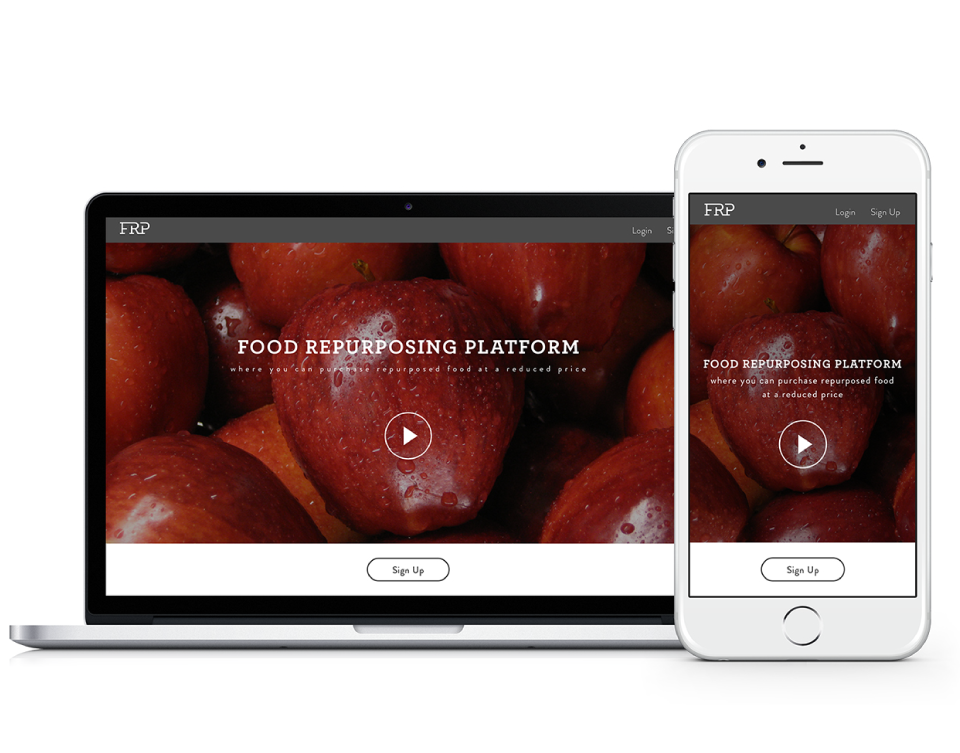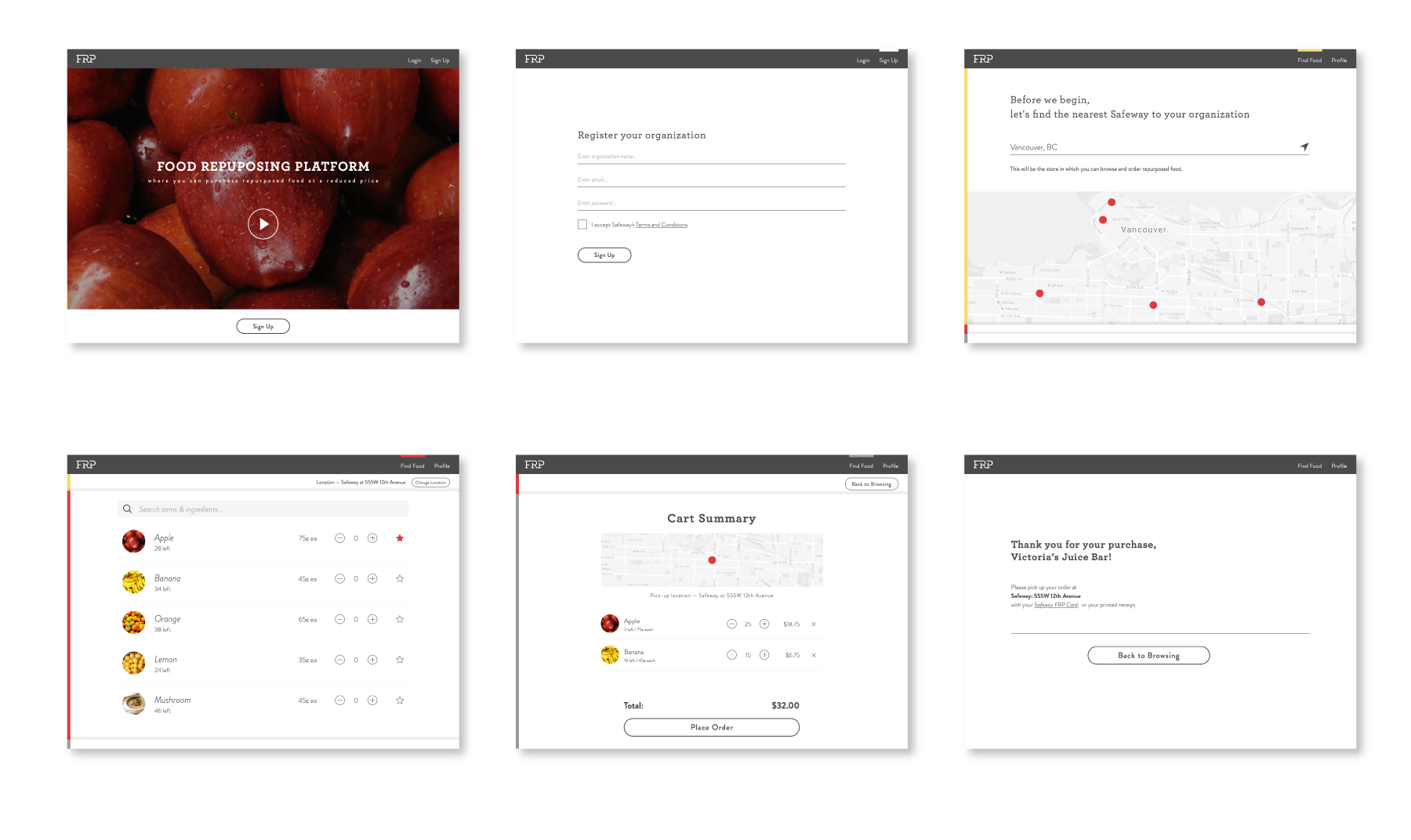
FOOD REPURPOSING PLATFORM
Food Repurposing Platform (FRP) is a digital and in-person service designed to get edible food that is wasted by grocery stores to businesses and organizations that can use.
The platform uses communications and brand identity to create awareness around food waste and celebrate associated businesses as industry leaders on the issue.
View presentationhere
Role
- UX Design
- UX Strategy
Team
- Fran Breden
- Charlie Chao
- Daria Ershova
- Armina Foroughi
- Solomon Hsu
- Edwy Woo
Tools
- Interviews
- Sketch
- Flinto
- Adobe Suite
PROMO VIDEO
PROBLEM SPACE
Every day, grocery stores in Canada throw away 8.5 million dollars’ worth of food. Much of this wasted food is still edible, but not marketable based on amount, appearance, or demand. However, this built-in cost of food waste can be transformed into value.

Waste cycle
We identified 4 points in produce’s life cycle where waste occurs. We focused on grocery stores as they have existing infrastructure such as storage, food scanning systems, and trained employees.
They are well-distributed within cities, making them accessible. They also have a large amount of edible waste.
solution
We’re proposing the Food Repurposing Platform (FRP) for Safeway. This platform connects small business and organizations to repurposed food in Safeway at an affordable price.
View market gap analysishere

FRP MODEL
Currently, Safeway’s food is divided into sellable food, compost, and a small amount of donations. Using our proposed system, Safeway workers would sort that food currently going to compost into two categories: compost and ‘b-grade’ edible produce.
Under the FRP model, Safeway workers sort out edible produce, scan and log that produce onto the FRP website, and it becomes available to purchase by local organizations.
Through the website, an organization’s representative signs up and selects their closest Safeway branch. The FRP then shows the available produce at that branch, from which they can order the items they want for next day pick up.
Customers
There is practical value for profit and non-profit users, so we have designed for two main potential markets: food businesses and food not-for-profit organizations.
The for-profit businesses include caterers and cafeterias, food processors, restaurants and juice stores.
Not-for-profits include food banks, food exchanges, and soup kitchens.
Value
For-Profit Businesses
- Sold at a cheaper price than ‘a-grade’ produce
- Fills unpredictable day-by-day needs
Nonprofit Organizations
- Higher volume than donations
- More choice and customization
- Raw produce, rather than pre-packaged food
Touchpoints

Overview

CORE EXPERIENCES
Based on our audience’s needs, values, and goals, we decided to focus on five core experiences within the service:
- Purchase flow
- Profile
- Brand experience
LAYERED PANELS
When considering the entire user journey framework, we narrowed it down to the three main steps - setting location, browsing, and checkout. We wanted explore alternatives from traditional breadcrumbs and came to layered panels. We wanted to invoke a sense of depth and motion to show a logical continuity between the steps.
One particular UI pattern we’ve employed is the use of layered panels. Because the find food experience of the website is a multi-step process, I wanted an intuitive way of orienting the audience on where they are in the flow without introducing cognitive overhead. Using coloured identifiers on the side, users would have a sense of where they are in the process.
PURCHASE FLOW
Despite the B2B nature of the platform, we wanted to create a delightful web experience that can organically reel in further engagement from FRP’s audience rather than following the traditional utilitarian approach.
This means keeping the aesthetics minimal and stripping away irrelevant details while focusing on making the key interactions as elegant as possible to guide the audience through the process.
Layered panels


PROFILE
When they tap on a point on the timeline they will see an approximation of their organization’s contribution to reducing food waste relative to the amount of food composted and what others in this specific community has contributed from the Safeway store.
The graph is meant to show the growth of relationship between Safeway and the participating businesses as well as to reinforce a sense of community and company contribution in making the change happen.

BRAND EXPERIENCE
We aimed for a positive brand perception transformation for both Safeway and participating businesses. Safeway FRP can also promote brand identity and awareness of the issue, much like Vancouver Aquarium’s Oceanwise initiative has done for sustainable seafood. Branded elements can be for community events, restaurant menus and pamphlets, as well as on Safeway’s website and in their stores.
Also, for the visual style, we wanted to have Safeway reflected in the visual design, but we also wanted to create/develop a separate identity for the platform, because of the scalability of this project.
Branding
